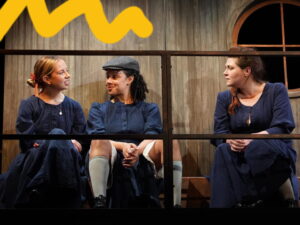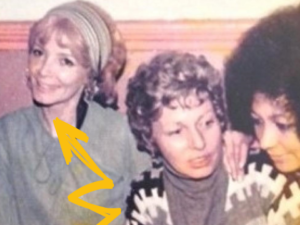
Liverpool Irish Festival are proud to present Jaki McCarrick speaking about her work Belfast Girls alongside Cherry Smyth’s Famished.
Featuring as part of our In:Visible Women strand, these two pieces focus on the unheard voices of the Irish Famine; the people forgotten by history, written out by poverty, class and discomfort with truth.
On writing ‘Belfast girls’: Jaki McCarrick
In 2010 I won the Papatango Prize for my all-male play Leopoldville. After a long period engaged in this work -from writing to performance- I began to think about writing a ‘sister’ piece with similar in energy, but for a female cast. Around the same time -having returned from London to Ireland to live (2007)- I became increasingly shocked by the crippling effects of the country’s now well-documented recession and subsequent bailout programme, resulting from paying international bondholders after the crash of Lehmans’ Bank. The daily news was full of reports of young people emigrating to Canada and Australia and there were several accounts of evictions and references in the media to the Irish Famine.
Ancestry
I began to wonder if any of my own ancestors had emigrated during the Irish Famine era. I googled ‘McCarrick’ and ‘Famine’ and found details of a register of young females leaving for Australia in 1850. One of the names on the register was Margaret McCarrick, from Sligo, my father’s birthplace. I read more, and discovered that 4,114 young females (supposedly between the ages of 14 and 19) had left Ireland between 1848 and 1851 as part of a relief effort called The Orphan Emigration Scheme. This had been established by Henry Grey, the Third Earl Grey; MP and Secretary of State for the Colonies.
In 2011 there seemed to be little information available in Ireland about such an important event (there’s a lot more information now, more scholarship, documentaries and novels). I read what I could find on the subject, including Robert Hughes’ The Fatal Shore, Thomas Kennelly’s History of Australia, Trevor McClaughlin’s Barefoot and Pregnant? Irish Famine Orphans in Australia, and Irish Women and Irish Migration edited by Patrick O’Sullivan. In reading these, I discovered a group among the orphan girls, considered to have been especially feisty and boisterous, known as ‘the Belfast girls’. I sensed then the makings of the female story I’d been looking for.
Brutality
Belfast Girls takes place entirely on a ship, The Inchinnon, which leaves Belfast Harbour for Australia in 1850 with a cargo of two hundred young women. Not all the girls on the ship are under 19; most have had horrific experiences in the Irish workhouses which, during the Irish Famine, were full to the brim. That many characters in Belfast Girls have experienced periods of prostitution speaks to the chaos and desperation of the Irish Famine years; this line of work being an act of survival, evidence of a degree of agency. Nonetheless, they want to leave this work, the workhouses, famine and a brutalised Ireland behind; they imagine sunshine and abundance ahead.
In reality, what often awaited these young female emigrants was the same or worse than the conditions they’d left (which is the real tragedy in the play). In her essay Beyond Brutal Passions: Prostitution in Early Nineteenth-Century Montreal Mary Anne Poutanen states that (with regards Canada) ‘female Irish emigrants were especially vulnerable to becoming prostitutes and increasingly prominent in Montreal’s sex trade in the late 1830s and early 1840s[i].
Context
With regards to the orphan girls sent to Australia, Trevor McClaughlin refers to reports alluding to the ‘calibre’ of young woman the Irish workhouses had dispatched:
Dr. Douglass in his evidence states that the greatest part of the Belfast girls are notoriously bad in every sense of the word … the women frequently charged each other with having children … they were addicted to stealing … and to using the most obscene and gross language … they openly charged each other with being public women.[ii]
As the Belfast girls conclude themselves, especially on seeing the negative Australian press responsding to earlier Irish orphan arrivals, it appears there was a semi-clearance sorts in the Irish workhouses (I use the word ‘purge’ in the play) of rebellious, unregulated women.
Process
After several months of research, I eventually wrote Belfast Girls in a white heat period of a few weeks. I sent the play to a couple of people and was contacted in late 2011 by theatre producer/director Robyn Winfield-Smyth, who said she would like it for a new season called Without Décor at The King’s Head Theatre (London). Without Décor was inspired by the early days of The Royal Court, when new work was staged without costume or set.
The play had a short rehearsal period and was shown without set, costume or lights. It was well-received. Soon director Svetlana Dimcovic and I found ourselves on attachment to the National Theatre Studio to develop Belfast Girls further. The play has since been published; translated several times and staged many times internationally. It had its New York premiere this year, produced by The Irish Repertory Company. I’ve also recently written Belfast Girls as a screenplay.
It’s been completely fascinating to witness audiences all over the world responding to what Professor Regina Buccola –who wrote the introduction to the published text– terms as ‘a matrix of class, race and gender oppressions’[iii] – despite the story of these women being close to two hundred years old. It’s been a joy to give the orphan girls their voice on stages around the world. Hopefully there will be further productions of the play in Ireland and the UK in 2023.
[i] Mary Anne Poutanen, Beyond Brutal Passions: Prostitution in Early Nineteenth-Century Montreal (2015), pp. 137–38, as cited in Jason King, ‘The Famine Irish, the Grey Nuns, and the fever sheds of Montreal: prostitution and female religious institution building’, Women and the Great Hunger, ed. by Christine Kinealy, Jason King, Ciaran Reilly, (Quinnipiac University Press, 2016), pp. 95 -107
Jason King, ‘The Famine Irish, the Grey Nuns, and the fever sheds of Montreal: prostitution and female religious institution building’, Women and the Great Hunger, ed. by Christine Kinealy, Jason King, Ciaran Reilly, (Quinnipiac University Press, 2016), pp. 95 -107, (p. 100).
[ii] Trevor McClaughlin, Barefoot and Pregnant? Irish Famine orphans in Australia, (The Genealogical Society of Victoria Inc., 1991), pp.76.
[iii] Regina Buccola, Introduction to Belfast Girls (Samuel French, London, 2015).
Image credit: Carol Rosegg.
Associated events (please note these may have passed)



